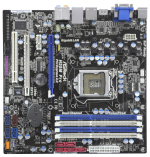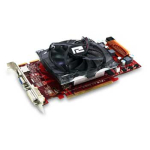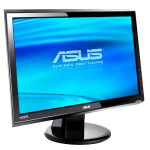System Buyers' Guide: PCs for Under $1000
by Sean Hollister on February 12, 2010 2:00 AM EST- Posted in
- Guides
Intel Mainstream PC
If you have a bit more to spend, the next step up the pricing ladder brings a lot to the table: the Intel Core i3-530, a best-in-class H55 motherboard, a 1080p LCD monitor and a bang-for-the-buck GPU to power it. Now we're talking.
| Intel Mainstream System | ||
| Hardware | Component | Price |
| Processor | Intel Core i3-530 (2.93GHz x2, 32nm, 4MB L3 Cache) |
$120 |
| Cooling | CPU Retail HSF | $0 |
| Video | PowerColor Radeon HD 4850 512MB | $100 |
| Motherboard | ASRock H55M Pro LGA1156 Micro ATX | $95 |
| Memory | G.Skill Ripjaws 4GB DDR3-1600 F3-12800CL9D-4GBRL | $105 |
| Hard Drive | WD Caviar Blue 500GB WD5000AAKS | $54 |
| Optical Drive | Sony Optiarc Model AD-7240S-OB 24X DVDRW SATA | $28 |
| Audio | Onboard | $0 |
| Case | Cooler Master Centurion 5 CAC-T05-UW Mid Tower ATX | $55 |
| Power Supply | OCZ ModXStream Pro 500W ATX12V SLI Certified, CrossFire Ready, 80 PLUS Certified Modular Active PFC (before $25 Rebate) | $65 |
| Base System Total | $622 | |
| Display | ASUS VH226H Black 21.5" 2ms(GTG) HDMI Widescreen 16:9 LCD (1920x1080) (before $20 Rebate) | $170 |
| Speakers | Cyber Acoustics CA-3090 26W 2.1 Speakers | $21 |
| Input | Microsoft B2L-00045 Comfort Curve Black USB Keyboard and Optical USB Mouse - OEM | $22 |
| Operating System | Microsoft Windows 7 Home Premium OEM 1-Pack (for System Builders) | $105 |
| Complete System Bottom Line | $940 | |
| Plus Estimated Shipping (within Continental U.S.) | $990 | |
| Rebates | -$45 | |
| Bottom Line (less tax, if applicable) | $945 | |
Though its price and associated requirements (LGA1156, DDR3) make it prohibitively expensive for entry-level rigs, we fully expect the Core i3-530 to be the starting point for bang-for-the-buck PC building guides around the globe anyhow. That's because at only $125, the Core i3-530 is not only the fastest dual-core processor available today, but also—with two logical threads per core—performs on par with the best budget quad-cores in most benchmarks. If that weren't enough, it features an on-die integrated graphics solution that rivals the best IGPs AMD has to offer (which isn't saying much, sadly) and it does it all while consuming less power than practically any other mainstream CPU out there. And thanks to its 32nm process and a 22x multiplier, it also overclocks to 4GHz using the stock cooler (YMMV).
 |
Paired with this Clarksdale wunderkind is the ASRock H55M Pro, the best, least-finicky H55 motherboard we've yet tested. Featuring the onboard VGA, DVI and HDMI video-out connectors and Flexible Display Interface needed to make use of the Core i3's Intel HD IGP, the board also features a superb layout. It has a pair of PCIe x16 slots (one at x16, one at x4), a PCIe x1 and a PCI slot arranged in a configuration where none of its ports are liable to be covered by expansion cards. Speaking of ports, the board comes with five neatly arranged SATA 3GB/s ports on the board and three USB 2.0 headers, with an eSATA, six USB2.0 ports, a combo PS/2, a single 1394a and optical S/PDIF out on the rear panel. 7.1 channel HD audio duties fall to the VIA VT1718S, while a Realtek 8111DL handles Gigabit Ethernet. There's even a TPM header.
While the board supports all current LGA 1156 Core i7, i5 and i3 processors, up to 16GB of DDR3-2600 memory and even Quad CrossFireX, it's not really a board you'd slot premium DIMMs or multiple GPUs into. We found it to have only moderate overclocking potential, and the PCIe x4 puts the kibosh on even regular CrossFire giving you your money's worth. But for $95, it's a wonderful board on which to build a mainstream PC.
 |
Given the fidelity of the onboard Intel HD Graphics, and assuming you don't care to play modern games in excess of 1024x768 resolution at minimum settings, a dedicated graphics card is honestly quite optional in a Core i3 and H55-equipped mainstream PC. Even without it, you can bitstream Dolby TrueHD and DTS HD-MA over the HDMI connection, handle hardware accelerated decoding of H.264/VC-1/MPEG2 streams, and drive large desktop screens. But because last year's mainstream rig included our editor-favorite Radeon HD 4770, it was hard to pass up the even more powerful, game-crunching $100 Radeon HD 4850. If you'd rather, you can get the slower Radeon HD 5670 for the same price and have access to DX11, Eyefinity and possibly 3D Blu-ray support later this year, or add $40 and get the best of both worlds with the faster Radeon HD 5750 1GB. Alternatively, you can save the $100, or put it towards one of the other goodies in our upgrade list on page 6. But know that when we were looking for a video card with enough value to automatically deserve a place in our mainstream rig, we immediately gravitated towards the 4850.
 |
While all other base components are the same known quantities we used for our entry-level rigs, we upgraded two peripherals for our mainstream PCs that deserve mention here. First, because in-monitor speakers are notorious for their low quality, we bring back last year's Cyber Acoustics CA-3090 2.1 speaker system, a fantastic value even at $20 (compared with $16, nine months ago). Second, we upgraded the LCD monitor to the ASUS VH226H. At $150 after rebate, the VH226H offers far more than $30 worth of extra value over the $120 VW193TR it replaces: it's a 21.5", 1920x1080 TN panel with a 2ms grey-to-grey response time, 1000:1 typical contrast ratio, and the all-important HDMI 1.3 input jack alongside standard DVI and VGA.










86 Comments
View All Comments
Taft12 - Friday, February 12, 2010 - link
Probably because double the cache (and a couple hundred MHz) is worth the $10 extra.Jaguar36 - Friday, February 12, 2010 - link
Could we get some power usage numbers on these setups? For the last cheap computer I built I think I've ended up paying more for the power to run it, than I paid for the system overall.FlyTexas - Friday, February 12, 2010 - link
Good job detailing the various parts and options.However, that is a lot of work to build something that will cost more than what you can just order from Dell and save all that trouble.
Yes, yes, the Dell is an OEM machine without the features and options you can play around with here, but really, if you're building a budget machine, you just want something that works well, not a super custom machine that you'll tinker with forever.
Right now, Dell is selling the following:
Inspiron 546
AMD Athlon II X4 630 (2.8GHz, 2MB)
Windows® 7 Home Premium, 64bit
20.0" Dell IN2010N HD Monitor
16X DVD+/-RW Drive
4GB Dual Channel DDR2 at 800MHz
750GB Serial ATA Hard Drive
Integrated ATI Radeon HD3200 Graphics
All for $599.
That is a faster processer, larger monitor, bigger hard drive, for $100 LESS than your custom computer.
And it comes pre-built, ready to use, with a warranty from a single company.
And if you want to play games, yes it has a 16x PCI-E slot to put a better video card in.
I would like to see an article here detailing what to order from HP/Dell/Etc. For example, if you don't need a monitor, the Dell Outlet is a great source for cheap computers.
Right now, in the Dell Outlet, you can get:
Inspiron 546
AMD Athlon II X4 630 (2.8GHz, 2MB)
Windows® 7 Home Premium, 64bit
16X DVD+/-RW Drive
6GB Dual Channel DDR2 at 800MHz
500GB Serial ATA Hard Drive
Integrated ATI Radeon HD3200 Graphics
For $389.
The Windows 7 alone is $105, that makes the hardware $284. Hard to beat that deal... That is for a Certified Refurbished machine, to be sure, however I've bought dozens of them over the past 3 years without any issues.
If you want to build a high end rig, you can do it for a lot less than Dell/Alienware will charge. If you want a budget rig, buy a Dell (or HP or whatever). Faster, for less money, and less hassle.
My 2 cents anyway.
Proud owner of a custom high end gaming rig and 10 Dell Vostro machines for everything else... because rolling my own is just work after the first one.
piasabird - Friday, February 12, 2010 - link
Dell is just So-So. It is not as junky as AMD, unless it is a junky AMD Dell.Windows 7 is priced $99.99 at www.directron.com
http://www.directron.com/gfc00599.html">http://www.directron.com/gfc00599.html
I couldnt tell if that includes shipping or not, so it may be about the same price.
Steele Phoenix - Friday, February 12, 2010 - link
I have done my own builds and bought budget computers from Dell as well. There are a couple issues that I really ran into:1) Video card MUST be only single slot. The 3 Dell's I have do not have room for a two slot width card. This is something that cannot be worked around without replacing the case. Requiring a single slot card makes it very difficult to upgrade video cards. Currently this will limit a user to a single 5770 option from HIS. All higher cards are two slot width.
2) Power supply must be replaced to support any video card that requires additional power. Once you do this the Dell warranty is technically void. You can still get support from Dell if you don't mention this but don't ship your computer back to them or ask a tech to come to fix something.
3) BIOS options are very limited.
4) External ports have very little options. No eSATA, Firewire etc.
Other than all of that your golden.
FlyTexas - Friday, February 12, 2010 - link
And this is why I'd like to see a complete article on build it yourself vs. OEM systems...1. Not always, there are mini-towers from Dell that will take a dual slot card. Not all of them, but more than you'd think. It isn't the dual slot that kills it, it is the length. However, I've put GTX9800+ cards into Dell's mini-tower cases just fine, and those are dual slot coolers. As for the AMD 5770, that card kicks the heck out of the 3200HD built in graphics these systems all come with. If you really want more than 5770 level graphics, you aren't building this level of system anyway. In my opinion, a 5850/5870 really needs a Core i5/i7 CPU to do it justice.
2. Not true, many Dell systems come with PCI-E power cables. The above GTX9800 cards require 2 of them. The Dell system had 1, and you can buy adapters to get a second one from the standard power cables. Works great.
3. Very true, you won't be overclocking the Dells...
4. True, but do you care on a $500 computer? Maybe, maybe not. It isn't hard to add either using a PCI or PCI-E 1x card to a Dell however.
Again, I'm not saying building your own is bad, I've built many of my own systems. I've also bought a lot of Dell's. They each have their benefits. Sometimes it just isn't worth the trouble to build your own. It all depends on your needs and what is important to you.
erple2 - Friday, February 12, 2010 - link
I agree with the vast majority of what you've said. Having said that, I can also see the additional value of buying your own components. Right now, to do a fairly substantial upgrade for me, I have to buy Motherboard, Memory and Processor (going from DDR2, Core2Duo to DDR3 and i5/i7) only. So my intermediate upgrade price is substantially lower than Dell (which, for the last 3 Dell's I've worked on, they still used a custom format Motherboard that was not attainable from, say, Newegg).However, if you're intermediate upgrades don't involve "just about anything", then there's not that much reason (at this price point) for buying something other than a pre-packaged system. Unfortunately, Dell's prices for warranties beyond the default 1 year is extremely cost prohibitive at this level (200+ dollars on a 600 dollar system)...
FlyTexas - Friday, February 12, 2010 - link
You are right about Dell's warranty upgrades beyond a year, they are expensive. I have never bought an extended warranty for a Dell desktop, and never needed one.However, I always buy 3 year warranties on my Dell laptops, and have used them more than once. The next day on-site service for something like a laptop is wonderful. Of course, spending $169 for a 3 year warranty on a $1,200 laptop makes sense. If it was a $500 laptop, I probably wouldn't. :)
Dell (and most big OEMs) actually do use a standard, the BTX form factor. You are correct, NewEgg doesn't sell motherboards in the BTX form factor, but NewEgg isn't the only place to buy stuff.
Google "btx motherboard Core 2" and click on shopping, you'll find something to use if you REALLY want to upgrade your 5 year old Dell. :)
But truth be told, what do you really save? If you have to upgrade the motherboard, CPU, RAM, etc. You're saving a case and a power supply, neither of which cost that much to begin with.
As someone else said, OEM systems aren't really meant to be upgraded, they are meant to be used for 3-5 years, then replaced with a new one. It would be interesting to compare spending $500 every 3 years compared to what some of us here spend upgraded every year. Heck, I've spent $500 on my last 2 video cards (the 8800GT, then the GTX260, they were $250 each when bought new), so I suppose it is all in how you look at it.
mm2587 - Friday, February 12, 2010 - link
while the big guys do offer some very competitively priced low end systems you do need to keep they also come with1) value ddr2 ram compared to high performance ddr3
2) a craptastic motherboard which has
a) no dvi port
b) no esata
c) no 7.1 sound
d) no optical out
e) probably no real bios options
3) a barely passable power supply
4) no side port memory and a weaker igp
I bet you could match the price of the new dell system if you went with lower end components then what was chosen. Its also completely unfair to compare new parts to refurb systems. You could drop the price of anandtech's system almost in half if you bout used parts.
FlyTexas - Friday, February 12, 2010 - link
Good points...1. DDR2 and DDR 3 cost about the same. Yes DDR3 is better going forward, however for such a basic system, does it really matter?
2. Dell's motherboards are generally made by Foxxcon, the same company that makes most of the fancy motherboards you already use. Believe it or not, there are not very many companies that actually make motherboards (or video cards for that matter). Dell's cheap boards are usually lean on features, but again this is a basic system.
2a. True, but for a 20" monitor, who cares? In any case, you'll have a DVI port if you upgrade the video card.
2b. Really? For a basic system we care about eSATA?
2c & d. Again, who cares... This is not a uber system, just a basic system. In my opinion, if you have a set of speakers to do 7.1 justice, you're spending a lot more on your computer than this.
2e. For sure, but again who cares, basic system remember?
3. The powersupply works fine, I've got GTX9800 cards running in 3 of these level systems and they don't complain, you don't need to spend $65 on a powersupply to get one that works.
4. The AMD 3200HD Graphics are not bad, better than most of what Intel provides. If you care about gaming, $50-100 fixes that right up.
Can you match the price of the Dell? Yes, but you have to drop everything down a bit, and you're still building it yourself...
From NewEgg:
Rosewill R2036-BK Black Computer Case 400W PS - $29.99
AMD Athlon II X4 630 2.8GHz - $101.99
ECS A780GM-M3 AM2+/AM3 Micro ATX Motherboard - $59.99
PQI POWER Series 4GB (2 x 2GB) DDR2 800 - $74.99
HITACHI Deskstar 500GB 7200 RPM - $54.99
SAMSUNG 22x CD/DVD Burner Black - $19.99
Acer X203H Black 20" 16:9 5ms LCD Monitor - $124.99
Windows 7 Home Premium OEM - $104.99
Rosewill Keyboard & Mouse Combo - $10.98
Shipping on all that is $15.06
Total price - $597.96
The same price as the Dell, and you have to build it, install Windows, and support it yourself. The Dell comes ready to use out of the box, gives you a place to call and get service for a year, and generally just works.
I'm not knocking building your own computer, for many people it makes sense. I've built more than I can count over the years. All I'm saying is that for this level of computer, for basic computer tasks, for someone who isn't a heavy upgrader or gamer, an OEM system works just fine with fewer headaches.